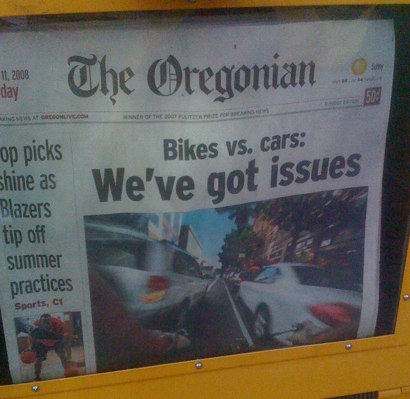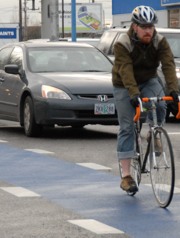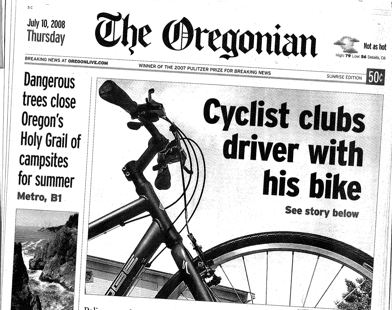
Like often happens when major bike-related news becomes the talk of the town, the last 24 hours have been a whirlwind of activity here at BikePortland headquarters.
Even though I have loads of other work to do, it is hard for me to think of anything besides the incident reported in The Oregonian yesterday.
And still, this morning, I remain disappointed and I have sort of a sick feeling in my stomach about the whole thing.

While I appreciate the discussion this story has started, I think the way it was framed from the outset — by both The Oregonian and their primary source for the story, the Portland Police Bureau — is having a negative impact on our city. In my inbox this morning, I already have two emails from people who say they were harassed (either verbally or by menancing driving) while biking into work this morning.
First, let me be clear. I think poor decisions were made by all parties.
That being said, I feel this is primarily about an assault that resulted after two people on the road had a disagreement and let their emotions escalate.
Sharing the road, and the tensions road users feel are definitely news, but characterizing this one instance as a major trend in “bicyclist vs. motorist” anger, and presenting the story in a way that pits one user group against another in a false dichotomy, is unnecessary, unproductive and dangerous.
In their follow-up piece today (also on the front page), the Oregonian writes:
“There’s an undercurrent of tension between cyclists and drivers that sometimes erupts into violence…”
Imagine that line above written a bit differently:
“There’s an undercurrent of tension on our roads that sometimes erupts into violence.”
The real issue goes way beyond “bicyclist vs. motorist”.
Case in point. Headlines in Seattle today share news of another road rage incident. A 60 year-old man was tending his garden in a traffic roundabout when he was assaulted and later died after an altercation with someone in a passing car about not driving over his hose.
I feel The Oregonian played on Portland’s reputation as a bike-friendly city and on this city’s appetite for bike-related news — especially when it has to do with the “bike vs. car” debate — in order to run a more sensational and attention-grabbing headline.

Making stories grab readers’ attention is one thing (I try to do it myself), but there is a line I feel should not be crossed.
In the short-run, The Oregonian might indeed sell a few more papers, but in the long-run I feel they’ve eroded public trust, hurt their brand (something they can ill-afford to do these days), and most importantly, fostered a dangerious animosity between Portlanders.

front page on January 20, 2006.
This is nothing new for The Oregonian. Back in 2006, in the wake of similar civic tensions following the infamous “Cyclist Sues Trimet” story, they ran a huge, front-page splash story titled, “Uneasy Riders.”
In that story, which I also expressed concerns about, reporter Joseph Rose referred to the bike/car relations in Portland as a “Cold War” and hinted that a “backlash against bicyclists” was about to begin. One of the photos accompanying the story showed a man on a bike from an old Critical Mass ride who was wearing a terrorist-like head scarf over his face similar to ones worn by extremists and militants.
As a publisher myself trying to make a living in the news business, I understand why they make their decisions and I understand they have no obligation to be sensitive about the issues. But as a citizen of Portland who understands the dire importance of traffic safety — where escalated emotions can lead to serious injury or even death — I wish they would be more careful with stories like these.
How does the coverage of Sunday’s incident compare with other road rage stories?
Sunday’s incident was plastered on the entire top half of the newspaper with the headline, “Cyclist clubs driver with his bike.”
In contrast, in a major road rage incident last year, a man in a car intentionally ran down a man on a bike on SE Clinton Street. The collision nearly killed Ben Ramsdell, and the man in the car also hit a second person on a bike in the same incident. The driver of the car later told KGW-TV that he was “frustrated the cyclist was not sharing the road.”
Where did that story end up? It was given a few lines of coverage in a roundup of other “Public Safety” stories that ran on page D2.
I find the difference in priority given to these two stories striking.
One component of the story that is particularly troubling is the “mob” mentality of the “angry” group of people that stopped to come to the aid of Steven McAtee (the man on the bike).
From what I’ve learned, the group formed after McAtee had been punched by someone and had fallen to the ground. Imagine yourself coming up on that scene. A car, a bike on the ground, its rider on the ground, the car driver not doing anything to help. It is completely understandable that some people would make the incorrect assumption that the bike rider was in need of support.
Do I condone mobs? Do I condone jumping to conclusions based on scant knowledge of what actually happened? Of course not.
But I understand that situations like this, that are charged with emotion and people yelling and people visibly hurt, are very confusing and it doesn’t take much for things to escalate. Add into the equation the psychology of someone on a 30 pound bike, who rides through the streets within inches of 3,000+ vehicles that with the smallest miscalculation could seriously injure or even kill them.
I don’t doubt that the people who stopped were boisterous and angry, but I just wish the Police Bureau could have been more sensitive in explaining the context of the situation.
What can we do to move this dialogue forward and try to make something positive out of this?
We are All Traffic is a nascent advocacy group that seems particularly well-suited to organize around this issue. You might remember WAAT as the group who helped the community come together in the wake of the two fatalities last October by holding a press conference at City Hall and a rally at Waterfront Park (that was attended (off-duty) by Police Chief Rosie Sizer).
One of the group’s organizers, Erin Greeson, describes WAAT as a “citizen coalition that works to improve safety and equality for all road users,” and says their efforts include working to help educate the media on transportation-related stories and issues.
Greeson feels that yesterday’s coverage of the road rage incident by The Oregonian was “sensationalist” and “a big step backwards”. Greeson says the Oregonian’s coverage,
“Generates new levels of road animosity — which is a life threatening issue — while reinforcing stereotypes and community divides. It is one of the most angering and disappointing pieces of reporting that I have seen this year. It is unacceptable. We can take action to prevent further cases of such irresponsible news coverage.”
WAAT is also planning a “State of the Streets” event in September. If you’re interested in getting involved, they are having a meeting to discuss actions and share ideas this Monday (7/14). For more details, send an email to eringreeson [at] gmail [dot] com.
I realize I’ve written at length about The Oregonian’s coverage. I do this because it had an immense impact on how Portlanders (and now the world) feel about what happened. I also realize there are other important issues that this story has helped bring to light. I plan on covering those in the days and weeks to come, as I’ve done on a daily basis for the past three years.
And, as always, I look forward to hearing your thoughts.
__________
[Editor’s note/update: I just updated this story (7/11, 9:55pm) with the photo from today’s newsstand edition of The Oregonian. As you can see from the photo, for the second day in a row, they have put this incident on the entire above-the-fold portion of the front page. I am also surprised they used the “Bikes vs. Cars” headline.
Back in October, in the wake of two fatal crashes in as many weeks, they used that same phrase to accompany a graphic/map of locations of recent car/bike collisions. I immediately contacted them and told them the “vs.” part was unduly divisive. They agreed and quickly changed the headline to “Bikes and Cars”. Too bad they did it again.]

